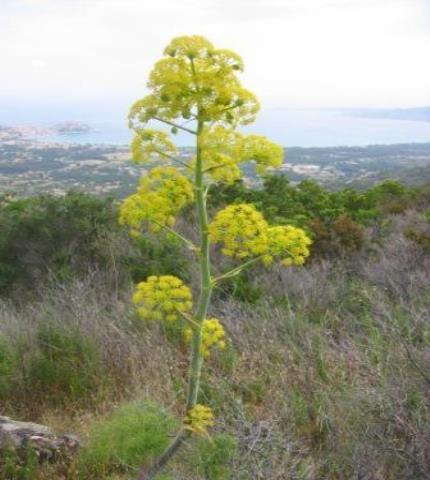
Ferula asa-foetida / الخيلة
Ferula foetida Regel, Ferula scordosma Bentley & Trim. Scorodosma foetidum Bunge
Haltit, Abo Kabeer, Anber Alfoqraa, Angedan
Asafoetida, Devil's Dung
Haltit, Al Keel, Al Kellah
Apeaceae
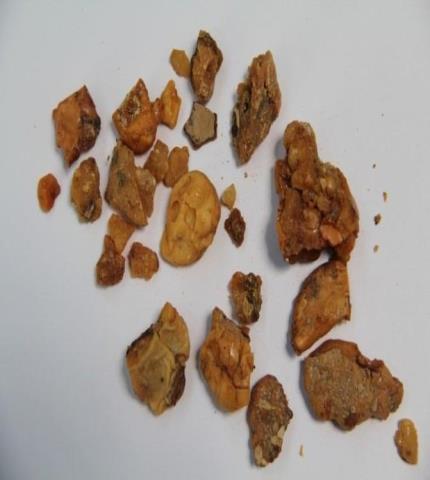
Resin
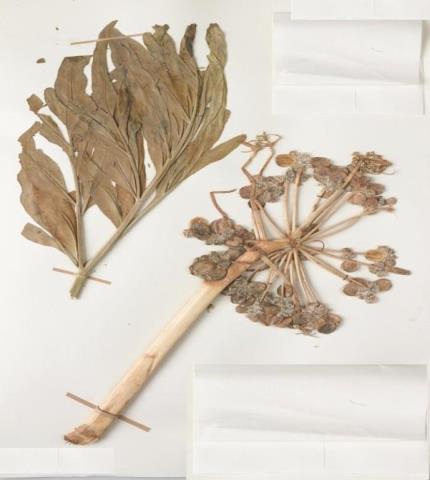
Herbarium specimen
Ethnobotanical Characteristics
Description
Plants 2-3 m tall with thick tap root. Leaves large, bipinnate, pubescent; segments oblong, entire, obtuse. The inflorescence densely pubescent. Umbels compact. Petals whitish-yellow, persistent. Fruit broadly oblong to suborbicular, 1 cm long, 8 mm broad; vittae inconspicuous, numerous, minute; fruit wing nearly as broad as the seed. (eFloras, Monographs of Unani Medicine, 2003)
Habitat and Distribution
South West Asia, imported to Arabia. The plant grows wild in Asia, Kashmir, Afghanistan and Persia. (Ghazanfar, 1994; Kapoor, 2001)
Part(s) Used
Oleo-gum resin
Traditional and Medicinal Uses
The oleo-gum-resin is used as an antispasmodic, for treating colic, as an expectorant and a sedative. Asafoetida is used widely in foods and is listed by the Council of Europe as a source of natural food flavoring. Asafoetida is approved for food use in US. Asafetida is stated to possess carminative antispasmodic, and expectorant properties. It has been used for chronic bronchitis, pertussis, laryngismus, stridulous, hysteria, and especially for flatulent intestinal colic. It is a valuable remedy for hysteria and nervous disorders of women and flatulence of children, flatulent colic, and spasmodic affection of the bowels, especially when connected with hysteria. Asafoetida is also used to treat nervous palpitations, hypochondriasis, and other affections due to hysteria, whooping cough, pneumonia, and bronchitis in children. In the UAE it is used as an aphrodisiac, digestive, tonic and liver and chest problems. (Ghazanfar, 1994, Newal 1996).
Pharmacognosy and Phytochemistry
Plant material of interest
Oleo-gum-resin
Asafetida, the oleo-gum-resin, obtained by incision of living rhizomes and roots of this plant, and the collected solidified material occurs as paste, tear or mass (block, lump or agglutinated tears). The paste and tear are the purer forms, but the bulk of the drug is available in the form of mass.
General appearance
The study samples are either opaque tears or blocks. They are irregular in shape, and several tears are cut into many surfaces. The majority are dull yellow in colour, and others have amber or purple colors, typical of Iranian or Afghani Asafoetida, while the odour is typical of the characteristic unpleasant alliaceous Asafoetida odour.
Microscopical Studies
Part studied
Oleo-gum-resin
The microscopical view of Asafoetida shows that it has no cellular structure since it is an oleo-gum-resin. A small slice of a typical tear of the drug shows purple, yellow and brown interlacing, irregular short lines or markings forming opaque or translucent areas. No plant debris or other foreign materials are detected.
Powdered plant material: The material consists of the pounded dry oleo-gum-resin of the most common variety in the UAE markets which is the amber or purple-coloured variety (Iranian or Afghani asafetida). It is a brownish-orange fine, homogeneous powder with a reddish tint and an observable stickiness. The powder has a strong characteristic alliaceous odour and a bitter, acrid taste having the same alliaceous flavor.
Microscopically, the powder shows triangular, oblong and other irregular shapes of brownish-orange opaque masses of the oleo-gum-resin that spread on the aqueous medium. Most of these masses show partial solubility in both cold and hot aqueous media, leaving thin opaque or translucent sheet-like masses or whitish matrices together with small particles of resinous materials.
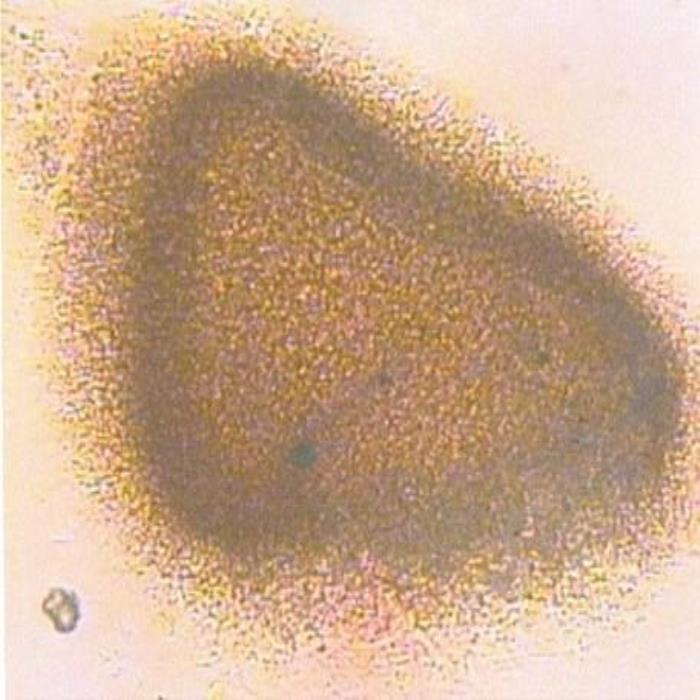
A) Slice of tear
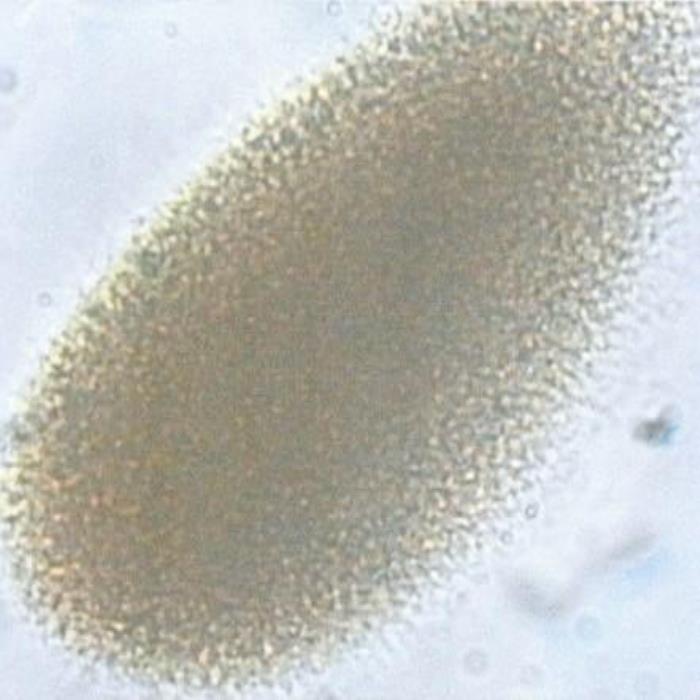
B) Another view of tear
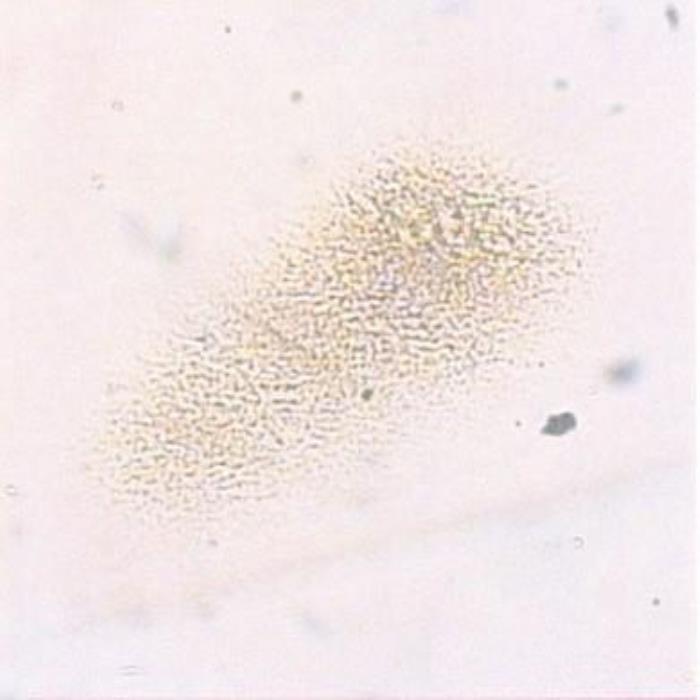
C) Very small slice of tear
- A. A small slice of a typical tear of Asafoetida oleo-gum-resin with purple, yellow and brown irregular short lines forming opaque or translucent areas but clear at the less dense parts of the tear at the outer parts.
- B. Another view of a small slice of tear of Asafoetida oleo-gum resin.
- C. A very small slice of a tear with yellow, purple and dark brown interlacing irregular short lines.
Chemical constituents
The oleo-gum-resin consists of volatile oil (10%), resin (50%), and gum (25%). The volatile oil contains terpenes, disulphides and pinene, and is mainly responsible for the therapeutic action of species (Bhagwan Das, 1997). The resin portion contains asareninotannols 'A' and 'B', ferulic acid, umbelliferone, and umbellic acid. The major constituent of Asafoetida oil is secondary butyl propenyl disulphide (C7H14S2), about 40-45 %. The other disulphides are C8H16S2, C10H18S2, and C11H20S2 (Singhal, 1997).
Sulphur-compounds in Asafoetida resin: 1-Methylpropyl-1-propenyl disulphide, 1-(Methylthio) propyl-1-propenyl disulphide, and 1-Methylpropyl-3-(Methylthio)-2- propenyl disulphide. (Ashutosh, 2003). Caffeic acid cinnamyl (2E)-3,4-dimethoxy cinnamyl-3-(3,4 diacetoxyphenyl) acrylate.) also reported from gum resin (Mohamed, 2007). Gum fraction contains Glucose, galactose, L-arabinose, rhamnose and glucuronic acid.
Resins contain Ferulic acid esters (60%), free ferulic acid (1.3%), asaresinotannols and farnesiferols A, B and C, coumarin derivatives (e.g., umbelliferone), coumarin–sesquiterpene complexes (e.g., asacoumarin A and asacoumarin B) (Joanne, 2007). A sesquiterpenoid coumarin, foetidin from the roots (J. Buddrus, 1985). The roots contents assafoetidnol A and assafoetidnol B, in addition to gummosin, polyanthin, badrakemin, neveskone, samarcandin and galbanic acid. (Mohamed, 2001).
Dimethyl trisulphide, 2-butyl methyl disulphide, 2- butyl methyl trisulphide, di-2-butyl trisulphide, di-2-butyl disulphide and di-2-butyl tetrasulphide as major components from oleogum resin (Rajanikanth, 1984). Asadisulphide, asacoumarin A and asacoumarin B from resin of roots. (Tetsuya, 1989). Assafoetidin and Ferocolicin from the gum resin (Banerji 1988).
The following chemical studies have been carried out on the on the gum resin of Ferula asafetida: (Quality Control methods, 1998; Evans, 1996) (ZCHRTM unpublished work):
Physicochemical constituents
Loss of weight in drying at 105°C : 6.60
Absolute alcohol solubility : 44.80
Water solubility : 22.80
Successive extractives (%)
Petroleum ether (60-80) °C : 7.05
Chloroform : 51.95
Absolute alcohol : 1.35
Ash values (%)
Total ash : 4.67
Water soluble ash : 0.67
Acid insoluble ash (10% HCl) : 0.84
pH values (aqueous solution)
pH of 1% solution : 7.308
pH of 10% solution : 6.848
Elemental analyses
Ash values (British Herbal Pharmacopeia)
Assay and identification of metal (AOAC International)
|
Apparatus |
AA-6800 Shimadzu-Flame method |
||||
| Element | Std. conc. µg/ml (ppm) | Sample conc.mg/ml | Samples absorbance | Actual conc.mg/ml | Actual conc. (%) |
|
Cr |
1, 2, 4 |
20 |
0.0034 |
0.0033 |
0.00033 |
|
Zn |
0.25, 0.5, 1 |
20 |
0.2926 |
0.0135150 |
0.00135150 |
|
Cu |
1, 2, 4 |
20 |
0.0124 |
0.003415 |
0.0003415 |
|
Fe |
1, 2, 4 |
20 |
1.1576 |
0.4656850 |
0.0465685 |
|
K |
1, 2, 4 |
1 |
0.1058 |
0.9521 |
0.09521 |
|
Pb |
1, 2, 4 |
20 |
0.0000 |
0.0000 |
0.0000 |
|
Cd |
0.25, 0.5, 1 |
20 |
0.0041 |
0.000185 |
0.0000185 |
|
Ca |
5, 10, 20 |
1 |
0.0903 |
16.9403008 |
1.69403008 |
UV Spectral studies
|
Ultraviolet Spectrum (USP reference) |
||||
|
Apparatus |
Milton Roy Spectronic Genesys 5 Spectrophotometer - Milton Roy. |
|||
|
Sample conc. (mg / ml) |
Solvent |
λ max (nm) |
λ min (nm) |
Abs.( λ max - λ min) |
|
0.55 |
Intestinal Fluid simulated without pancreatic pH=7.50.1 |
286 310 |
256 298 |
0.838 - 0.527 0.790 -0.763 |
|
0.82 |
Gastric Fluid simulated without pepsin pH =1.20.1 |
289 319 |
259 |
0.915-0.562 1.002 |
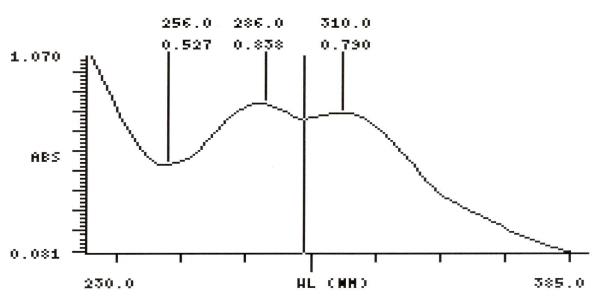
Intestinal Fluid simulated without pancreatic

Gastric fluid simulated without pepsin
Chromatographic Studies
Thin layer chromatography (Wagner and Bladt, 1996)
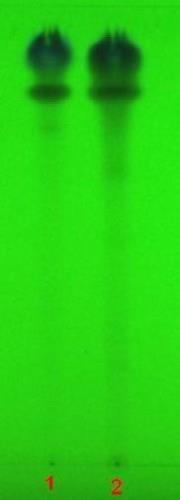
A
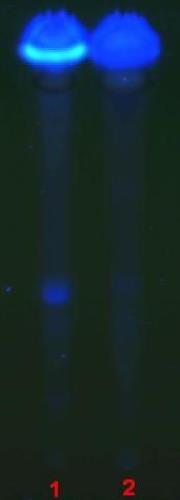
B

C
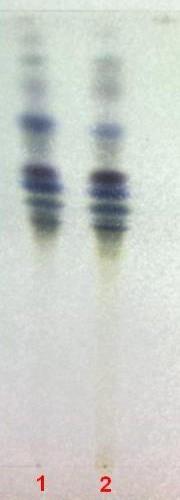
D
TLC fingerprint of Petroleum ether 60-80°C (track 1) and Methanol extract (track 2)
|
Mobile phase Fig. |
A&B |
: |
Ethyl acetate, methanol, water (100:13.5:10) |
|
|
C |
: |
Toluene, ethyl acetate (93:7) |
|
|
D |
: |
Toluene, ethyl formate, formic acid (5:4:1) |
| C | : | Ethyl acetate, methanol, water (100:13.5:10) | |
|
Detection |
A |
: |
UV 254nm |
|
|
B |
: |
UV 366nm |
|
Derivatization |
C&D |
: |
Vanillin-Sulphuric acid-vis |
Pharmacological & Toxicological studies
The following information was reported about the plant in the literature;
Ferula asafoetida is a plant native to Iran (Middle East) and has a strong sulfurous smell. The sap of the stem and roots is dried and crushed to form an onion tasting powder, which is frequently used in Indian and Middle Eastern cuisine. Ferutinin, but not teferin and teferdin, significantly inhibited female receptivity. These results suggest a primary role of ferutinin in the impairment of sexual behavior elicited by F. hermonis extract in hormone primed-female rats (Zavatti ,2006). The molluscicidal activity of dried root latex powder of Ferula asafoetida, flower-bud powder of Syzygium aromaticum and seed powder of Carum carvi against the snail Lymnaea acuminata was studied showed significant molluscicidal activity (Kumar ,2006).
Ferula asafoetida was studied on Schistosoma mansoni in experimentally infected mice is investigated caused highest reduction in worm burden and eggs (Ramadan et al., 2004). Ferula penninervis showed antioxidant activity (Kogure, 2004). The effects of Ferula hermonis on protein degradation, lipid peroxidation, erythrocyte deformability and osmotic fragility of erythrocytes exposed in vitro showed anti-protein-oxidant activity (Suboh, 2004).
The effects of Ferula asafoetida gum extract on the contractile responses of the isolated guinea-pig ileum induced by acetylcholine, histamine and KCl, and on the mean arterial blood pressure of rat were investigated showed variety of muscarinic, adrenergic and histaminic receptor activities or with the mobilization of calcium ions required for smooth muscle contraction non-specifically (Fatehi, 2004).
The seed acetone extract of Ferula gummosa protected mice against tonic convulsions induced by maximal electroshock (Sayyad, 2002), the Ferula gummosa essential oil and its various extracts are relaxant of rat isolated ileum and that at least part of their inhibitory effect is due to alpha-pinene and beta-pinene components. As is the inhibition of contractile over-activity of the ileum (Sadraei, 2001)
The effect of fennel essential oil on uterine contraction as a model for primary dysmenorrheal has been reported (Ostad, 2001). Saleem, 2001 reported it as a potent antioxidant that can protect against free radical mediated diseases such as carcinogenesis. The coumarin (4-hydroxycoumarins) isolated from Ferula communis showed Anticoagulant activity (Lamna-ouer, 1999)
The following pharmacological and safety evaluation studies were carried out on the plant extract of Ferula asafetida. (Derelanko 2002; Han, 2003).
Summary of the results
|
ACTIVITY |
RESULTS |
|||
|
Strong |
Moderate |
Mild |
Negative |
|
| Analgesic (Hot plate) | √ | |||
|
Antidepressant |
|
|
|
√ |
|
Anticonvulsant |
|
√ |
|
|
|
Anti-inflammatory |
|
|
|
√ |
|
Effect on rabbit jejunum |
√ |
|
|
|
|
Effect on rat fundus |
|
√ |
|
|
|
Effect on Guinea pig ileum |
|
√ |
|
|
|
Gastrointestinal activity ↓ |
|
√ |
|
|
|
Effect on right rat atria |
|
√ |
|
|
|
Anaesthetized rat BP & HR |
|
√ |
|
|
|
Effect on intracavernous tissue |
|
√ |
|
|
|
Coagulation activity |
√ |
|
|
|
|
Acute toxicity |
|
|
√ |
|
|
Locomotor activity test ↓ |
|
√ |
|
|
|
Motor co-ordination (grip strength & motor activity |
|
|
|
√ |
|
Effect on biochemical parameters |
|
|
|
√ |
|
Studies on hematological parameters |
|
|
√ |
|
|
Body weight |
|
|
|
√ |
|
Mortality |
|
|
|
√ |
The animals were administered with suspension of plant resins at the dose of 400 mg/kg., p.o. using metabolic cages to check the feces output in rats and was found to reduce the gastrointestinal motility and also reduced gastrointestinal emptying. The effect of Ferula resins at this concentration showed inhibition of the normal intestinal propulsion. The plant resin showing prokinetic action or reducing propulsive action of the gut caused a moderate inhibitory effect / anti-spasmogenic activity/ Spasmolytic activity. The extract was also found to reduce the spontaneous contraction of the isolated guinea-pig ileum provides a base for treatment of intestinal disorder including relieving stomach pain/ a source of antispasmodic agents. Evaluation PB and HR on Anaesthetized rat’s model showed the plant extract decreased rat blood pressure in a dose-dependent manner. The plant extract showed a negative chronoscopic effect. A significant reduction in the beating rate in isolated rat atria, indicating that the extract possesses some actions related to a decrease in blood pressure, i.e., vasodilating action, a decrease in cardiac output.
In the study on effect of sexual erectile activity using intracavernous tissue the plant extract produced a pronounced relaxation in phenylephrine-pre-contracted corpus cavernous tissue. The animals treated with the plant extract at the dose of 1 g/kg daily for six days exhibited prolonged onset time and also produced a pronounced reduction of convulsions.
The test substance produced no significant inhibition of the inflammation; showed no effect on antidepressant activity. At the dose of 5 g/kg., p.o, plant resin produced signs and symptoms showing system inhibition preceded by an excited state, in mice. Some mice lost the righting reflex after about 2 h of administration of resin suspension. However, signs and symptoms depend on the dose. Quantification of serum biochemical changes, the results indicate that no significant change in any of the parameters observed as compared to control. Hematological analysis showed that the parameter WBC was found to decrease in treated group. However, rest of the parameters examined showed no significant change. The study of the Ferula effect on blood clotting showed a significant increase in the level of fibrinogen in the blood.

The effect on isolated rat atria
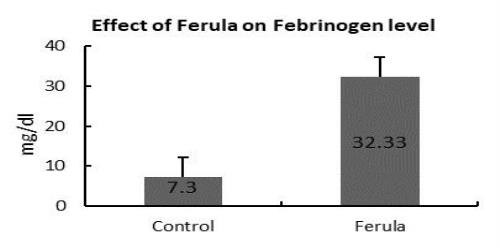
The effect on Fibrinogen level

The relaxation effect on the isolated rabbit jejunum
Antimicrobial studies
The aqueous extract of the whole plant was tested against Mycobacterium smegmatis, C. tropicalis, different strains of Staphylococcus aureus (Including ATCC 257) as well as Methicillin Resistant Staphylococcus aureus, different strains of E. coli (Including ATCC UN 109), different strains of ESBL-producing K. pneumonia, E. coli, Pseudomonas aeruginosa, the extract was found to be very active against C. tropicalis, Staphylococcus aureus and Mycobacterium smegmatis only.
References
- Ashutosh Kar. Pharmacognosy And Pharmacobiotechnology. New Age International. New Delhi 2003. Page: 382.
- Banerji, B. Mallick and A. Chatterjee, H. Budzikiewics and M. Breuer. Assafoetidin and ferocolicin, two sesquiterpenoid coumarins from ferula assafoetida regel. Tetrahedron Letters, Volume 29, Issue 13, 1988, Pages 1557-1560.
- Bhagwan Dash,Acharya Manfred M. Jounious. Handbook of Ayurveda. Concept Publishing Company. 1997. Page 116
- Carol A. Newal et al. Herbal medicines – a guide for healthcare professionals, Pharma. Press, London, p.38, 1996.
- Fatehi M, Farifteh F, Fatehi-Hassanabad Z. Antispasmodic and hypotensive effects of Ferula asafoetida gum extract. J Ethnopharmacol, 2004, 91: 321-324.
- Flora of Pakistan; www.efloras.org
- J. Buddrus, H. Bauer, E. Abu-Mustafa, A. Khattab, S. Mishaal, E. A. M. El-Khrisy and M. Linscheid. Foetidin, a sesquiterpenoid coumarin from Ferula assa-foetida. Phytochemistry. Volume 24, Issue 4, 1985, Pages 869-870.
- Joanne Barnes, Linda A. Anderson, J.D. Phillipson. Herbal Medicines, 3rd Edition. Pharmaceutical Press. 2007.
- Kogure K, Yamauchi I, Tokumura A, Kondou K, Tanaka N, Takaishi Y, Fukuzawa K. Novel antioxidants isolated from plants of the genera Ferula, Inula, Prangos and Rheum collected in Uzbekistan. Phytomedicine, 2004, 11:645-651.
- Kumar P, Singh DK. Molluscicidal activity of Ferula asafoetida, Syzygium aromaticum and Carum carvi and their active components against the snail Lymnaea acuminata. Chemosphere, 2006, 63:1568-1574.
- L.D. Kapoor. Handbook of Ayurvedic Medicinal Plants, CRC Press, USA, p.185, 2001.
- Lamnaouer D. Anticoagulant activity of coumarins from Ferula communis L. Therapie, 1999, 54:747-751.
- Mohamed H. Abd El-Razek, Shinji Ohta, Ahmed A. Ahmed, Toshifumi Hirata. Sesquiterpene coumarins from the roots of Ferula assa-foetida. Phytochemistry 58 (2001) 1289–1295.
- Mohamed H. ABD EL-RAZEK. A New Ester Isolated from Ferula assa-foetida L. Biosci Biotechnol Biochem. Vol. 71 (2007), No. 9 pp.2300-2303.
- Monographs of Unani Medicine, Vol.1, Trad. Med. Div. Nat. Inst. Health, Pakistan, p.240, 2003.
- Ostad SN, Soodi M, Shariffzadeh M, Khorshidi N, Marzban H. The effect of fennel essential oil on uterine contraction as a model for dysmenorrhea, pharmacology and toxicology study. J Ethnopharmacol, 200, 76: 299-304.
- Rajanikanth, B. Ravindranath and M.L. Shankaranarayana. Volatile polysulphides of asafoetida. Phytochemistry. Volume 23, Issue 4, 1984, Pages 899-900.
- Sadraei H, Asghari GR, Hajhashemi V, Kolagar A, Ebrahimi M.Spasmolytic activity of essential oil and various extracts of Ferula gummosa Boiss. on ileum contractions. Phytomedicine, 2001, 8: 370-376.
- Saleem M, Alam A, Sultana S. Asafoetida inhibits early events of carcinogenesis: a chemopreventive study. Life Sci, 2001, 68:1913-1921.
- Sayyad M, Mandgary A, Kamalinejad M.Evaluation of the anticonvulsant activity of the seed acetone extract of Ferula gummosa Boiss. Against seizures induced by pentylenetetrazole and electroconvulsive shock in mice. J Ethnopharmacol, 2002, 82: 105-109.
- Shahina A. Gazanfar. Handbook of Arabian Medicinal Plants, CRC Press, USA, p.208, 1994.
- Shlosberg A, Egyed MN. Stability of prothrombin times in sheep dosed with natural and synthetic anticoagulants. Res Vet Sci, 1986, 40:141-143.
- Singhal, R.S.; Kulkarni, P.R.; Rege, D.V. Handbook of Indices of Food Quality and Authenticity. 1997 Woodhead Publishing. Page :395
- Suboh SM, Bilto YY, Aburjai TA. Protective effects of selected medicinal plants against protein degradation, lipid peroxidation and deformability loss of oxidatively stressed human erythrocytes. Phytother Res. 2004,18:280-284.
- Tetsuya Kajimoto, Kiyoshi Yahiro and Toshihiro Nohara. Sesquiterpenoid and disulphide derivatives from ferula assa-foetida. Phytochemistry. Volume 28, Issue 6, 1989, Pages 1761-1763.
- Zavatti M, Montanari C, Zanoli P . Role of ferutinin in the impairment of female sexual function induced by Ferula hermonis. Physiol Behav, 2006 3:656-661
